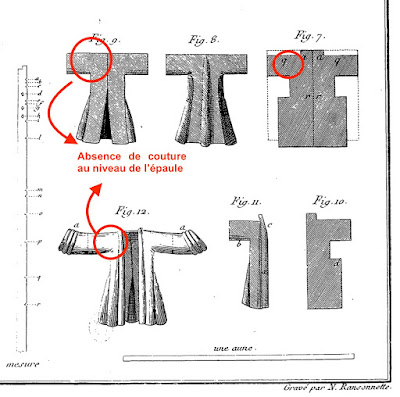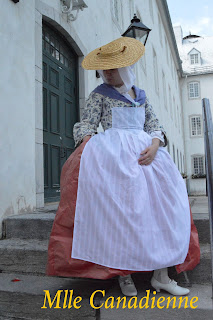This year, I decided to make my articles in english separately from the one in french when it's long texts.
I have noticed that there is some confusion in female clothing called ''déshabillé''. An 18th century ''déshabillé'' is the ordinary clothing to wear casually, the opposite of the court gown or being dressed for Sunday. The term ''déshabillé'' is usually used by wealthy people. Common people would more add white accessories to their everyday clothes, because they did not have money enough to have a completely different kit for Sundays.
First the bedgown. It's an inside clothing for rich people. For poorer, it may be worn in the public space.
From de l'Art du tailleur contenant le tailleur d'habit d'homme; les culottes de peau; le tailleur de corps de femmes et enfants: la couturière; et la marchande de Modes by M. de Garseault, 1769
On this engraving, we can see that there is no sewing at the shoulder (see red circles). This is a pice of clothing almost not fitted so less expensive to sew and easy to do. The front close by overlapping the two borders or with ribbon. The back has a big pleat that look a little alike the classical french gown but much more simple.
Les cris de Paris (1737-1746); Pommes cuites au four, Edmé Bouchardon
No seam at the shoulder
Les cris de Paris (1737-1746); Vendeuse de pommes, Edmé Bouchardon
Overlapping of the fronts parts
Anonymous portrait from anonymous painter
Overlapping of the fronts parts and no seam at the shoulder
Overlapping of the fronts parts and no seam at the shoulder
Reproduction of a bedgown using the commercial pattern Kannick's Korner I have sewn, worn by Cathrine Davis.
Crédit photo: Joseph Gagné
Crédit photo: Joseph Gagné
Reproduction of a bedgown using the commercial pattern Kannick's Korner I have sewn, worn by Cathrine Davis.
Crédit photo: Joseph Gagné
Crédit photo: Joseph Gagné
The jacket, called mantelet by french-canadians and juste or justaucorps by people from Old France it a more fitted clothing. It was make for someone with musellement like most of 18th century clothing. the front can be closed by ribbons, pins, little enclosures and sometime a stomacher. The back is flat without pleats. The basques can be splitter or full. The sleeves can be more fitted and end in ''pagodes'' or be less fitted and end with a ribbon. The jacket will always have a different fabric than the petticoats.
La belle chocolatière, 1743-1743 by Jean-Étienne Liotard (I haven't found the museum)
This jacket has fitted sleeves with pagodes and full basques (the skirt of the jacket)
This jacket has fitted sleeves with pagodes and full basques (the skirt of the jacket)
La pourvoyeuse, 1739 by Jean Siméon Chardin (museum of Louvres, Paris)
This jacket has a large sleeve with a contrasting ribbon to hold the sleeve at the elbow.
This jacket has a large sleeve with a contrasting ribbon to hold the sleeve at the elbow.
La fontaine, 1733 by Jean Siméon Chardin ( I haven't fount the museum)
It's probably the same maid of the other painting, La pourvoyeuse. The ribbon on the sleeve has been removed so the sleeve is full long length. Also, we see the seam at her shoulder and the split of the basques near her bum.
It's probably the same maid of the other painting, La pourvoyeuse. The ribbon on the sleeve has been removed so the sleeve is full long length. Also, we see the seam at her shoulder and the split of the basques near her bum.
My reproduction of an ''indienne'' jacket, made by Evelyne Bouchard with fitted pagodes sleeves, full basques and ribbons to close the front.
My reproduction of an ''indienne'' jacket, made by Evelyne Bouchard with fitted pagodes sleeves, full basques and ribbons to close the front.
Often the difference is hard to tell in paintings or engravings between jackets or bedgown. Look at the sleeve: if there is no seam at the shoulder, it's a bedgown. If there is a seam at the shoulder it may be a jacket or a half-robe (demi-robe in french). Demi-robe is like a full gown but shorter on the length.
Exemple of demi-robe
Fêtes galantes of Filippo Falciatore found on Sotheby's
I hope that may help you to recognize bedgown from jackets on paintings and engravings.
Mlle Canadienne















